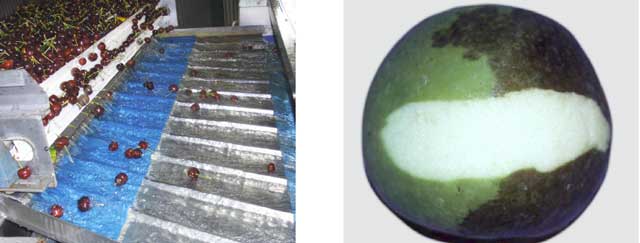Other postharvest diseases that are primarily a problem during storage include blue mould, grey mould, ripe fruit spot and transit rot.
Postharvest dipping and drenching (cont from last issue)
Dipping or drenching the fruit as it comes into the storage and packing facility is essential for minimising potential fruit losses.
Equipment and water transport systems
Many postharvest temperate fruit handling and grading systems (such as in apples and cherries) use water flumes to transport fruit from harvest bins to sorting, washing lines and packing lines.
The water used must be properly treated to prevent bacterial and fungal pathogens spreading, potentially causing fruit infections and food safety issues.
Good packing house hygiene and sanitation (including dump tank and flotation conveyors) is crucial for reducing the build-up of fungal spore populations and should be a part of food safety and good postharvest practices.
Superficial scald
Superficial scald (scald) is a long-term storage disorder of apples (particularly Red Delicious and Granny Smith) and pears.
Scald is a physiological disorder, which means it occurs randomly during storage and is not caused by a disease.
Scald is characterised by brown irregular patches on the skin during long-term cold storage. These areas become sunken and turn darker brown as the disorder develops. Although the damage is only superficial, it is sufficient to greatly downgrade fruit quality and grower returns.
Scald symptoms develop slowly in cold storage, usually within three months of harvest, and increase with time in storage. They will rapidly increase in severity within a few days at ambient air temperatures.
Scald incidence
Several inter-related varietal, orchard and management factors influence the incidence of scald, including tree vigour and nutrition, preharvest temperatures, sunlight, rainfall, fruit size and mineral content.
However, the major factors influencing scald susceptibility are: (cont next issue)
Download the Orchard plant protection guide
See this article in Tree Fruit May 2022




















